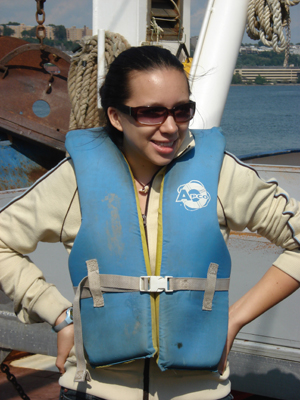

| Enterococci Main Page | Enterococci Presentation | 2006 Entero Event Results | 2007 Entero Event Results |
|---|
For the 2006 Snapshot Day several Snapshot Day sites gathered water samples for a Barnard College student working on her senior thesis. Suzanne’s (pictured above) thesis focuses on the harbor area around 125th Street. The city is currently developing this area into Harlem Piers encouraging fishing, kayaking and other water activities (excluding swimming) to achieve the goal of providing more people recreational access to the river. This can be complicated by the number and placement of the many Combined Sewage Overflows (CSO) that exist throughout New York City. For more information on CSOs follow this link to the EPA webage on this topic. It should be noted that the samples were taken within 12 hours of a rain event large enough to have had an impact through the CSO outfalls.
Suzanne used the collected water samples to look at the levels of enterococci around 125th Street and other areas of the river. Her study focuses on whether the water quality in the 125th Street area is within acceptable standards for recreational use. Additionally, she hoped to include a review of the relationship between the combined sewer outfall which is directly below the pier construction site, and levels of enterococci bacteria in that area.
Background
Enterococci are commonly found in the feces of humans and other warm-blooded animals and can be used as an indicator of water quality and the presence of pathogens. Previous testing in the Hudson River, and other waterways has focused on Fecal coliform tests, but recent research has suggested enterococci is a better measure in brackish and marine waters. There are some strains of enterococci that are not related to fecal pollution, however, the presence of enterococci in water is an indication of fecal pollution and the possible presence of enteric pathogens.
The EPA guidelines note "Studies have led to the development of criteria which can be used to determine recreational water standards based on established relationships between health effects and water quality. The significance of finding enterococci in recreational fresh or marine water samples is the direct relationship between the density of enterococci and the risk of gastrointestinal illness associated with swimming in the water". The EPA standard for a single sample maximum is 104 Colony Forming Units (104) per 100ml. Any sample in excess of this 104 CFU would be above acceptable range for recreational water.
Summary of Method
The method Suzanne used is based on EPA July 2006 standards. Water samples were collected from the Hudson in designated locations using two 50 ml collection tubes providing a total of 100 ml of sample water in each location. Samples were collected from the top 12 inches of the water, and after collection were stored on ice, but not frozen, for no longer than 24 hours before filtering and incubating. The samples were then prepared by filtering the water through a membrane to collect the bacteria. The membrane with the bacterial cells is then placed on a selective agar to incubate for 24 hours at 41°C. The colonies of bacteria are then counted. All colonies greater than or equal to 0.5 mm in diameter (regardless of color) with a blue halo are counted as enterococci colonies.